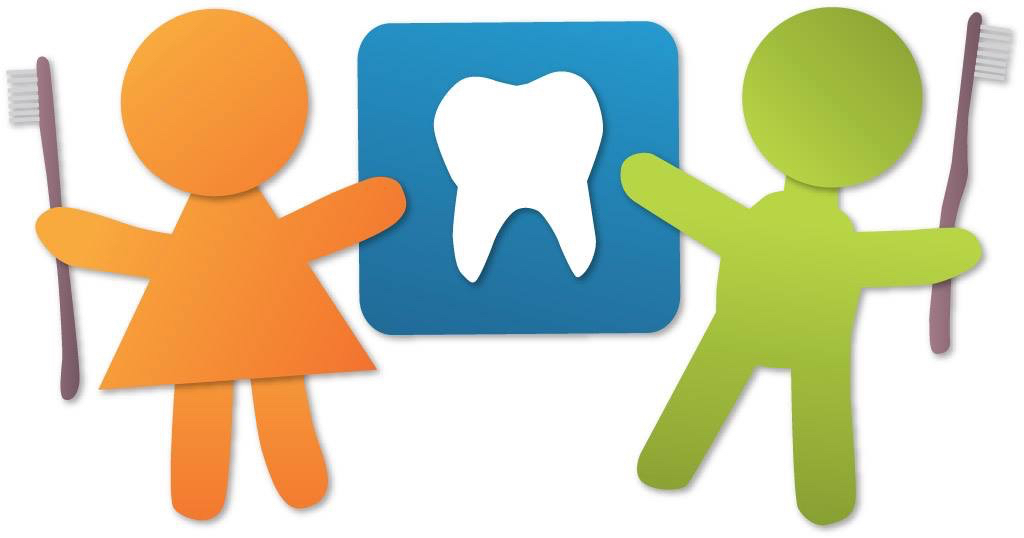In children, a loose tooth is usually the result of a baby (primary) tooth becoming loose to make room for the adult tooth or the result of trauma.
In the case on the left, the new adult (permanent) tooth is starting to grow (erupt) into the oral cavity. However, the primary tooth has not fallen out. If you see this in your child's mouth, please call us for an appointment. We may have to help your child by taking out the baby tooth to allow the new tooth to come into the mouth correctly.
What to do for a loose baby tooth:
Have your child "wiggle" the tooth themselves, pushing it a little at a time everyday. As more of the root of the tooth goes away, the baby tooth will usually come out by itself. This may happen spontaneously, or during eating. If you can see the new tooth coming in through the gums and the baby tooth is slightly loose but not enough for your child to remove it, call our office for an appointment. It is important to remove over-retained primary teeth so that the new permanent tooth can come in straight.
What to do after an accident:
If your child's tooth is loose due to an accident, rinse and cleanse the injured area with warm water and then check for broken tooth fragments. If all the teeth are intact, gently touch the traumatized teeth to check for looseness. If you notice slight bleeding around a damaged tooth and the tooth is not very loose, you can monitor your child at home. Keep your child on a soft diet for a few days to prevent further damage to the teeth and soft tissues. The bleeding should stop shortly, and the tooth should tighten over time.
If the tooth is loose and in a different position (pushed into the bone, pulled out, or pushed to one side or another), please call our office for an appointment. We will need to take x-rays to check for possible root damage and determine what treatment is necessary.
The traumatized tooth may darken over time. This just means that red blood cells have been forced into the hard part of the tooth from the blood vessels in the nerve (pulp) tissue. The traumatized baby teeth may change into an array of colors, from pink to dark gray. This color change does not necessarily mean that the tooth needs to be removed. It only means that the tooth has suffered some type of trauma and needs to be watched closely. Sometimes, a traumatized tooth or teeth will need subsequent removal weeks or months after the trauma. Signs to watch for include complaints of dental pain, seeing an abscess or bubble on the gums above or below the traumatized teeth, constant fidgeting with, touching, or avoiding the tooth in very young children. In any of these cases, please call our office to schedule an appointment.
Place cold compresses over the area of the injury on your child's face. You can use a towel or gauze to hold pressure on any bleeding areas. You may give your child Children's Tylenol (Acetaminophen) or Children's Motrin/Advil (Ibuprofen) to relieve pain and use ice compresses over swollen areas. Neosporin can be used to prevent infection for any external cuts or scratches. Keep your child on a soft diet for 2 weeks to prevent further damage. Call our office if you have any other questions or if symptoms get worse.
Call your local emergency room if the following occurs:
- Chills, fever, or vomiting
- Difficulty walking or change in gait
- Severe increase in swelling or pain
- Inability to swallow or keep liquids down
- Bleeding that does not stop even after continued pressure for 20 minutes
Call us for a followup appointment if the following occurs:
- The bleeding has stopped, but the area continues to bother your child
- A tooth or teeth appear to be very loose and not tightening after a reasonable amount of time
Loose tooth following trauma
Tooth put back in original place and splinted
Doctor Wang, Doctor Perea-Corkish, Doctor Gerodias and the other Doctors of Discovery Pediatric Dentistry make no warranties, expressed or implied, as to any results to be obtained from use of the information on this page. We cannot diagnose or treat patients over the Internet. Information on this site is for educational purposes only. You should not rely on this information as a substitute for personal, medical, and/or dental attention or diagnosis. Without all available information about a patient, it is impossible to make a diagnosis. Help and answers are in the form of general ideas. Only you, your dentist, and other necessary and qualified health care providers can make an appropriate treatment decision in an emergency or for everyday care and dental treatment.


